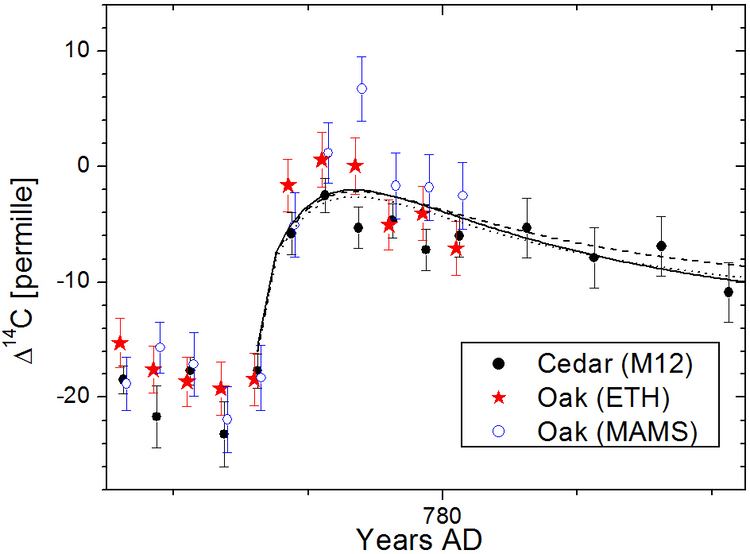 | ||
The 774–775 Carbon-14 Spike is an observed increase of 1.2% in the concentration of carbon-14 isotope in tree rings dated to the years 774 or 775 CE, which is about 20 times as high as the normal background rate of variation. It was discovered during a study of Japanese cedar trees, with the year of occurrence determined through dendrochronology. A surge in beryllium isotope 10Be, detected in Antarctic ice cores, has also been associated with the 774–775 event.
Contents
The event appears to have been global, with the same carbon-14 signal found in tree rings from Germany, Russia, the United States, and New Zealand. A "red crucifix" was recorded by the Anglo-Saxon Chronicle as appearing in the skies of Britain for the year 774; since no supernova remnant has been found for this year, it is interpreted as an aurora borealis.
In China, there are no clear references to an aurora in the mid 770s CE, as happened on 762; and "comet"-sightings of the 770s do not match the expected atmospheric phenomena. Instead an anomalous "thunderstorm" was recorded for 775.
The signal exhibits a sharp increase of ~1.2% followed by a slow decline (see Figure 1), which is typical for an instant production of carbon-14 in the atmosphere, indicating that the event was short in duration. The globally averaged production of carbon-14 for this event is calculated as Q= (1.1-1.5)×108 atoms/cm2.
Hypotheses
Several possible causes of the event have been considered.
The common paradigm is that the event was caused by a solar particle event (SPE) from a very strong solar flare, perhaps the strongest ever known, but still within the Sun's abilities. Another discussed scenario of the event origin, involving a gamma-ray burst, appears unlikely since the event was also observed in isotopes 10Be and 36Cl.
Frequency of similar events
The event of 774 is the strongest spike over the last 11,000 years in the record of cosmogenic isotopes, but it is not unique. A similar event occurred in 993 or 994, but it was only 0.6 times as strong. Several other events of the same kind are also suspected to have occurred during the Holocene epoch.
From these statistics, one may expect that such strong events occur once per tens of millennia, while weaker events may occur once per millennium or even century. The event of 774 did not cause catastrophic consequences for life on Earth, but had it happened in modern times, it may have produced catastrophic damage to modern technology, particularly to communication and space-borne navigation systems. In addition, a solar flare capable of producing the observed isotopic effect would pose considerable risk to astronauts.
